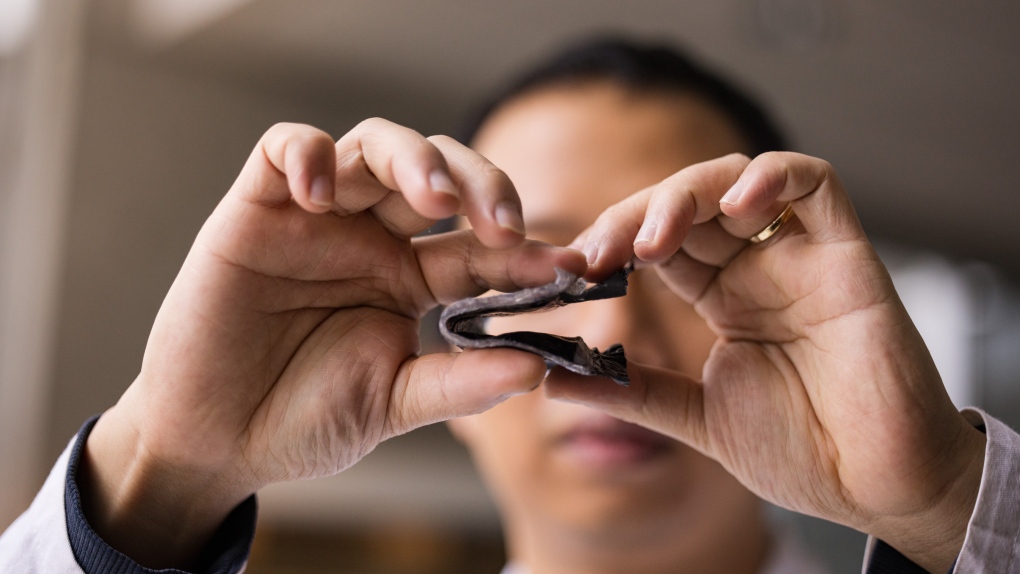Canadian designed product may be first ever flexible, washable battery
 A stretchable, washable battery is held up by researcher Ngoc Tan Nguyen in a photo provided by the University of British Columbia.
A stretchable, washable battery is held up by researcher Ngoc Tan Nguyen in a photo provided by the University of British Columbia.
A battery designed by researchers in British Columbia is thought to be the first that is both flexible and washable.
Researchers at the University of British Columbia say the battery "brings wearable devices closer to reality," and is so durable that it can survive being washed with the laundry.
Those behind the product added in a statement issued by the school Thursday that it is so flexible it will still work if twisted or stretched to twice its normal length.
It was developed by a group of researchers including postdoctoral fellow Ngoc Tan Nguyen, of UBC's faculty of applied science.
Nguyen said these types of batteries are essential to the development of increasingly popular wearable electronics.
"Up until now, stretchable batteries have not been washable. This is a critical addition if they are to withstand the demands of everyday use," he was quoted as saying in UBC's statement about the battery.
HOW DID THEY DO IT?
According to Nguyen's team, most batteries contain internal layers of hard materials.
The team was able to create a flexible version by grinding up zinc and manganese dioxide – key components that make alkaline batteries work – and then embedding them in a "rubbery plastic, or polymer."
These chemicals were chosen because they're safer to wear next to the skin than those used in lithium-ion batteries, Nguyen said.
These polymers were then layered and wrapped in a casing of the same polymer, rather than the more rigid materials used to encase layers of non-flexible batteries.
The researchers said the way the new battery was built included a waterproof,airtight seal to protect the internal components.
And it really was tested by putting it through the wash, UBC said. It's since survived 39 wash cycles.
According to the school's statement, team member Bahar Iranpour came up with the idea.
"We put our prototypes through an actual laundry cycle in both home and commercial-grade washing machines. They came out intact and functional and that’s how we know this battery is truly resilient," Iranpour said.
NEXT STEPS
However, it may be a while before the battery is actually incorporated into any wearable tech.
The next step for researchers will be to increase how long the battery lasts, and to make it more powerful.
But they're hopeful when it does go to market, it will be an affordable option, with a price comparable to what a consumer would pay for rechargeable batteries.
According to John Madden, an electrical and computer engineering professor who supervised the work, the materials they used are low-cost, so if the batteries are mass produced, they'll be cheap.
In terms of devices, Madden said the battery may be used in watches or patches that measure vital signs, including heartbeat. Expanding further, he said the technology could also be integrated with machine-washable clothing that can actively change colour or temperature.
CTVNews.ca Top Stories

Trump threatens to try to take back the Panama Canal. Panama's president balks at the suggestion
Donald Trump suggested Sunday that his new administration could try to regain control of the Panama Canal that the United States “foolishly” ceded to its Central American ally, contending that shippers are charged “ridiculous” fees to pass through the vital transportation channel linking the Atlantic and Pacific Oceans.
Wrongfully convicted N.B. man has mixed feelings since exoneration
Robert Mailman, 76, was exonerated on Jan. 4 of a 1983 murder for which he and his friend Walter Gillespie served lengthy prison terms.
opinion Christmas movies for people who don't like Christmas movies
The holidays can bring up a whole gamut of emotions, not just love and goodwill. So CTV film critic Richard Crouse offers up a list of Christmas movies for people who might not enjoy traditional Christmas movies.
Can the Governor General do what Pierre Poilievre is asking? This expert says no
A historically difficult week for Prime Minister Justin Trudeau and his Liberal government ended with a renewed push from Conservative Leader Pierre Poilievre to topple this government – this time in the form a letter to the Governor General.
New York City police apprehend suspect in the death of a woman found on fire in a subway car
New York City police announced Sunday they have in custody a “person of interest” in the early morning death of a woman who they believe may have fallen asleep on a stationary subway train before being intentionally lit on fire by a man she didn't know.
More than 7,000 Jeep SUVs recalled in Canada over camera display concern
A software issue potentially affecting the rearview camera display in select Jeep Wagoneer and Grand Cherokee models has prompted a recall of more than 7,000 vehicles.
'I'm still thinking pinch me': lost puppy reunited with family after five years
After almost five years of searching and never giving up hope, the Tuffin family received the best Christmas gift they could have hoped for: being reunited with their long-lost puppy.
10 hospitalized after carbon monoxide poisoning in Ottawa's east end
The Ottawa Police Service says ten people were taken to hospital, with one of them in life-threatening condition, after being exposed to carbon monoxide in the neighbourhood of Vanier on Sunday morning.
Pickup truck driver killed by police after driving through Texas mall and injuring 5
A pickup truck driver fleeing police careened through the doors of a JCPenney store in Texas and continued through a busy mall, injuring five people before he was fatally shot by officers, authorities said.

































